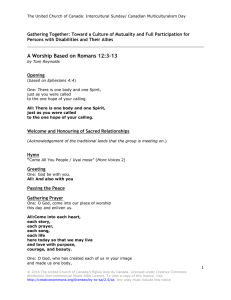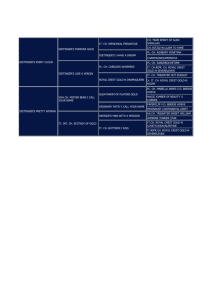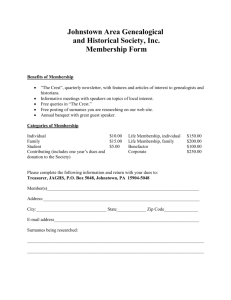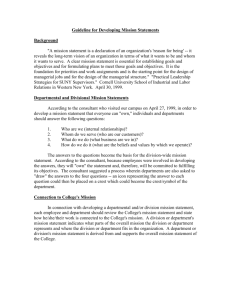Sing to Our God! - The United Church of Canada
advertisement
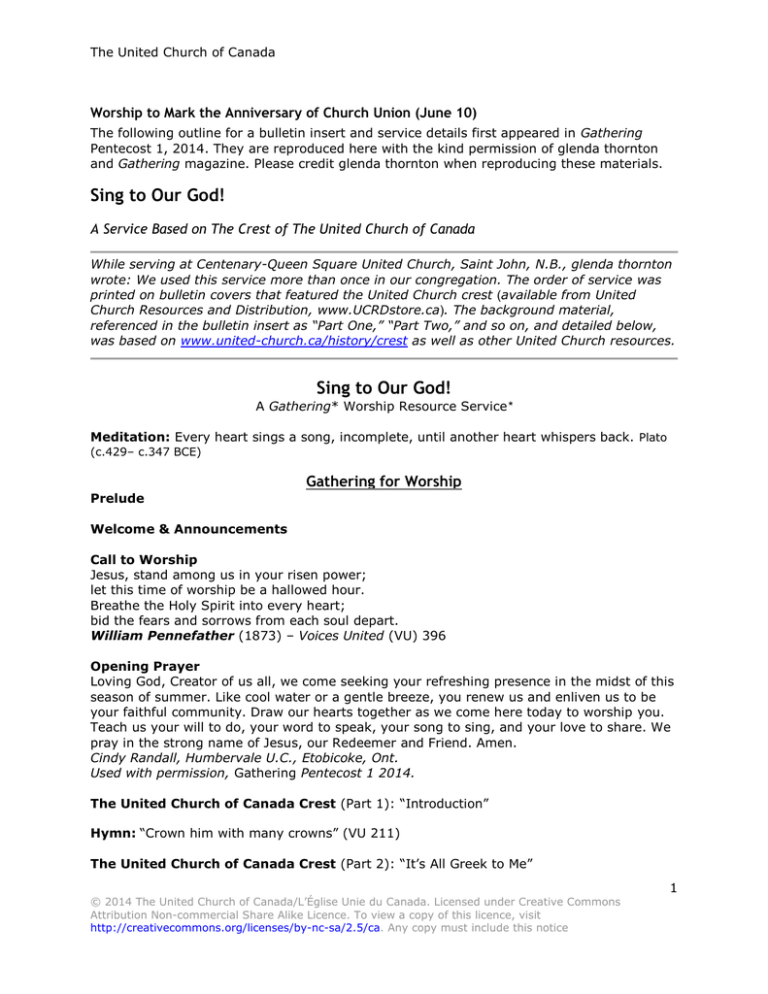
The United Church of Canada Worship to Mark the Anniversary of Church Union (June 10) The following outline for a bulletin insert and service details first appeared in Gathering Pentecost 1, 2014. They are reproduced here with the kind permission of glenda thornton and Gathering magazine. Please credit glenda thornton when reproducing these materials. Sing to Our God! A Service Based on The Crest of The United Church of Canada While serving at Centenary-Queen Square United Church, Saint John, N.B., glenda thornton wrote: We used this service more than once in our congregation. The order of service was printed on bulletin covers that featured the United Church crest (available from United Church Resources and Distribution, www.UCRDstore.ca). The background material, referenced in the bulletin insert as “Part One,” “Part Two,” and so on, and detailed below, was based on www.united-church.ca/history/crest as well as other United Church resources. Sing to Our God! A Gathering* Worship Resource Service* Meditation: Every heart sings a song, incomplete, until another heart whispers back. Plato (c.429– c.347 BCE) Gathering for Worship Prelude Welcome & Announcements Call to Worship Jesus, stand among us in your risen power; let this time of worship be a hallowed hour. Breathe the Holy Spirit into every heart; bid the fears and sorrows from each soul depart. William Pennefather (1873) – Voices United (VU) 396 Opening Prayer Loving God, Creator of us all, we come seeking your refreshing presence in the midst of this season of summer. Like cool water or a gentle breeze, you renew us and enliven us to be your faithful community. Draw our hearts together as we come here today to worship you. Teach us your will to do, your word to speak, your song to sing, and your love to share. We pray in the strong name of Jesus, our Redeemer and Friend. Amen. Cindy Randall, Humbervale U.C., Etobicoke, Ont. Used with permission, Gathering Pentecost 1 2014. The United Church of Canada Crest (Part 1): “Introduction” Hymn: “Crown him with many crowns” (VU 211) The United Church of Canada Crest (Part 2): “It’s All Greek to Me” 1 © 2014 The United Church of Canada/L’Église Unie du Canada. Licensed under Creative Commons Attribution Non-commercial Share Alike Licence. To view a copy of this licence, visit http://creativecommons.org/licenses/by-nc-sa/2.5/ca. Any copy must include this notice The United Church of Canada Scripture: John 20:19–29 Time with Children: All My Relations – Akwe Nia’Tetewá:neren Hymn: “Many and great, O God, are your works” (VU 308) The Proclamation of the Word The United Church of Canada Crest (Part 3): “God’s Truth” Scripture: Psalm 119 (VU pp. 840–841, Part Five); Matthew 3:1, 5, 13–17 The United Church of Canada Crest (Part 4): “A Dove Descending” Hymn: “Love divine, all loves excelling” (VU 333) The United Church of Canada Crest (Part 5): “On Fire!” Scripture: Exodus 3:1–6 The Response to God’s Word Presentation of Our Lives and Offerings Prayer of Dedication: (Say together the words of…) “Your work, O God, needs many hands” (VU 537) Hymn: “The church’s one foundation” (VU 331) The United Church of Canada Crest (Part 6): “The Beginning and the End” Scripture: Revelation 21:5–7 Hymn: “In Christ there is no east or west” (VU 606) Prayers of the People The United Church of Canada Crest (Part 7): “Fishing for a Different Catch” Scripture: Luke 5:1–11 Hymn: “Will you come and follow me” (VU 567) The United Church of Canada Crest (Part 8): “Conclusion” Hymn: “Sent forth by God’s blessing” (VU 481) Commissioning & Benediction Choral Amen: (VU 974) 2 © 2014 The United Church of Canada/L’Église Unie du Canada. Licensed under Creative Commons Attribution Non-commercial Share Alike Licence. To view a copy of this licence, visit http://creativecommons.org/licenses/by-nc-sa/2.5/ca. Any copy must include this notice The United Church of Canada Service Details (Part 1) Introduction The crest of The United Church of Canada is on our bulletin today. This insignia is a spiritual and historic reminder to the members of the United Church across Canada. But how much do we know about it? How did it come to be? What do the symbols mean? Today, we will be exploring the crest: its history and the meaning of the symbols. The crest is the official signature of The United Church of Canada, to be placed on all legal documents. It was designed by the Rev. Dr. Victor T. Mooney, who was Treasurer of the United Church at the time. In his own words: “When I was appointed Treasurer of The United Church of Canada, I discovered that the church had no seal to seal the documents of the church. Shortly after the 1925 Union, the Executive had ordered that a seal be designed for the United Church, and a committee was appointed to look into it and make recommendations. However, no report was ever made to the Executive. The committee had appointed an expert in seals for documents, several designs were made, but they had not appealed to the committee, so they had not presented them. They did, however, decide that they should work into it symbols that would represent the various denominations coming into union. Because I was always doodling in the meetings, the then Moderator, Dr. Slater, said, ‘Let’s appoint Mooney the chairman of a new committee; he’s always doodling. He ought to be able to work out a design.’” That was in 1943, and Mooney’s design was officially adopted in 1944 by the 11th General Council. (Part 2) It’s All Greek to Me The crest is designed in the form of a St. Andrew’s cross with an insignia in each of the four corners. The X at the centre represents the Greek letter “chi,” which is the first letter of the Greek word for Christ: Christos, the source of the English word Christ. Because of this, the X has become a traditional symbol for Christ. In August of 2012, at the 41st General Council, The United Church of Canada acknowledged the presence and spirituality of Aboriginal peoples in the United Church by revising the church’s crest. The crest changes included incorporating the colours often associated with the Aboriginal Medicine Wheel. The Medicine Wheel, which reflects respect for diversity and interdependence, is often represented in the four traditional colours of yellow, red, black, and white, which incorporate important teachings from the four directions, the four stages of life, and the four seasons. The placement of these colours will vary according to the traditions of the nation. The Medicine Wheel teaches us to seek balance in the physical, mental, emotional, and spiritual aspects of the circle of life. (Part 3) God’s Truth Three of the four symbols on the crest are associated with the three communions that united to form The United Church of Canada in 1925. The open Bible on the left side of the crest represents the Congregational Church and its emphasis upon God’s truth that makes people free. From this communion we have a heritage of liberty in prophesying, love of spiritual freedom, awareness of the creative power of the Holy Spirit, and clear witness for civic justice. These qualities all come from their history. Congregationalism began back in the time of the Puritan Reformation in Great 3 © 2014 The United Church of Canada/L’Église Unie du Canada. Licensed under Creative Commons Attribution Non-commercial Share Alike Licence. To view a copy of this licence, visit http://creativecommons.org/licenses/by-nc-sa/2.5/ca. Any copy must include this notice The United Church of Canada Britain. Congregations that did not conform but were still Protestant and ran themselves independently and autonomously became known as Congregationalists. Congregationalism in Canada originated with the acceptance of the offer made by the British government that promised free land to New Englanders who would relocate in Nova Scotia. In 1759, several hundred immigrants founded new towns and gathered churches; the first was at Chester, N.S., and in 1760, a colony began at Maugerville, New Brunswick, with their first church being organized six years later. The churches in Newfoundland were organized in 1846. In 1801, the British Congregationalists sent a missionary to organize a church in Quebec. That beginning led to the formation of the Congregational Union of Ontario and Quebec, which merged with the older Atlantic group in 1906. It was this union of Congregational Churches that joined The United Church of Canada in 1925. (Part 4) A Dove Descending The dove at the top of the crest symbolizes the Holy Spirit, whose transforming power has been a distinctive mark of Methodism. Here, our heritage is one of evangelical zeal, concern for human redemption, warmth of Christian fellowship, the testimony of spiritual experience, and the ministry of sacred song. The Methodist movement traces its origin to the evangelical awakening in 18th-century Great Britain. Methodism followed from the work of John Wesley, who was an Anglican clergyman. Methodism in Canada is traced to Lawrence Coughlan, an Irish Methodist preacher who came to Newfoundland in 1765. Around the same time, Methodists were migrating from England to Nova Scotia; among them was William Black, Sr., whose young son of 19 organized Methodist classes in 1781. Three years later, Black journeyed to Baltimore, Maryland, for the meeting that organized the new Methodist Episcopal Church. The Canadian work that Black had developed was taken under their care and prospered as an integral part of the Methodist Episcopal Church until 1828, when it became separate and independent. Meanwhile, Methodists from Great Britain had migrated into Upper Canada and brought with them the several divisions of British Methodism. Mergers in 1874 and 1884 resulted in The Methodist Church of Canada being formed, and this was the church that joined the United Church in 1925. Our next hymn is written by Methodist Charles Wesley, John Wesley’s brother: “Love Divine, All Loves Excelling.” (Part 5) On Fire! The burning bush at the right of the crest is the symbol of Presbyterianism and the indestructibility of the church. From the Presbyterians, we have received a heritage of high regard for the dignity of worship, the education of all people, the authority of scripture, and the church as the Body of Christ. A form of Calvinism, Presbyterianism traces its roots back to the Scottish Reformation, Scotland’s formal break with the Roman Catholic Church in 1560. Later, in 1598 in France, the Edict of Nantes was issued by Henry IV to grant the Calvinist Protestants of France (also known as Huguenots) substantial rights in a nation still considered essentially Catholic. French Huguenots, escaping persecution following the revocation of this edict in 1685, brought the Reformed Faith to Canada. But even in the New World, their growth and development were restricted. After Britain took over Nova Scotia in 1713, subsequent 4 © 2014 The United Church of Canada/L’Église Unie du Canada. Licensed under Creative Commons Attribution Non-commercial Share Alike Licence. To view a copy of this licence, visit http://creativecommons.org/licenses/by-nc-sa/2.5/ca. Any copy must include this notice The United Church of Canada immigration of Presbyterians from Scotland and Ireland completely overwhelmed the small French contingent. The first ministers from Scotland were Daniel Cook, David Smith, and Hugh Graham, who organized the Presbytery of Truro in 1786. In 1795, the Presbytery of Pictou was organized, which represented another faction of Scottish Presbyterianism. In 1817, these two groups, joined by a few ministers from the Established Church of Scotland, were able to come together and form the Synod of the Presbyterian Church of Nova Scotia. Meanwhile, Presbyterians were moving into central and western Canada. As in eastern Canada, they brought the many divisions of the Scottish church with them and established several presbyteries and then synods, the first being the Presbytery of the Canadas in 1818. The establishment of new synods continued through the first half of the 19th century, in part due to the importing of divisions within the church in Scotland, the arrival of nonEnglish-speaking immigrants (Dutch Reformed), and the opening of new territories in the west. In 1875, a series of mergers led to the union of most Presbyterians into The Presbyterian Church of Canada. Seventy percent of congregations in this denomination joined the United Church in 1925. (Part 6) The Beginning and the End The symbols of alpha and omega in the lower quarter of the crest are the first and last letters of the Greek alphabet. They symbolize the eternal living God, in the fullness of creation. (Part 7) Fishing for a Different Catch The oval shape of the crest is derived from the outline of a fish, a symbol of identity adopted by early Christians. The fish was depicted as a Christian symbol in the first decades of the second century. The symbol itself may have been suggested by the miraculous multiplication of the loaves and fishes or the meal of the seven disciples, after the Resurrection, on the shore of the Sea of Galilee. Its popularity among Christians was due principally, it would seem, to the famous acrostic consisting of the initial letters of five Greek words forming the word for fish (Ichthys), which words briefly but clearly described the character of Christ and the claim of believers: Iesous Christos Theou Yios Soter, meaning Jesus Christ, Son of God, Saviour. (Part 8) Conclusion The Latin words “ut omnes unum sint,” found on the lower left side of the outline, mean “That all may be one” and are taken from John 17:21: “I ask not only on behalf of these, but also on behalf of those who will believe in me through their word, that they may all be one. As you, [God], are in me and I am in you, may they also be in us, so that the world may believe that you have sent me.” On the lower right side, we find the Mohawk phrase “Akwe Nia’Tetewá:neren,” which means “all my relations.” This phrase connects with Jesus’ prayer and reflects the spirituality of Aboriginal peoples that acknowledges our interrelationship with all of creation. With these words, we are reminded that we are both a united and uniting church. Our United Church of Canada, the largest Protestant denomination in Canada, was the first union of churches in the world to cross historical interdenominational lines. Along with the Congregational Church, the Methodists, and the Presbyterians, the General Council of Union 5 © 2014 The United Church of Canada/L’Église Unie du Canada. Licensed under Creative Commons Attribution Non-commercial Share Alike Licence. To view a copy of this licence, visit http://creativecommons.org/licenses/by-nc-sa/2.5/ca. Any copy must include this notice The United Church of Canada Churches from Western Canada also joined in 1925. Since then, the Synod of the Wesleyan Methodist Church of Bermuda and the Canada Conference of the Evangelical United Brethren Church have become part of The United Church of Canada as well. We are also reminded that as a denomination we seek right relationship among all people and with creation itself. Our crest not only reflects the history of our country, but reveals that we have come from a variety of faiths, different and dissenting perhaps, but all believing in one God, one Lord, Jesus Christ, and one Holy Spirit. Thanks be to God. Please credit glenda thornton, while at Centenary-Queen Square U.C., Saint John, N.B. 6 © 2014 The United Church of Canada/L’Église Unie du Canada. Licensed under Creative Commons Attribution Non-commercial Share Alike Licence. To view a copy of this licence, visit http://creativecommons.org/licenses/by-nc-sa/2.5/ca. Any copy must include this notice
